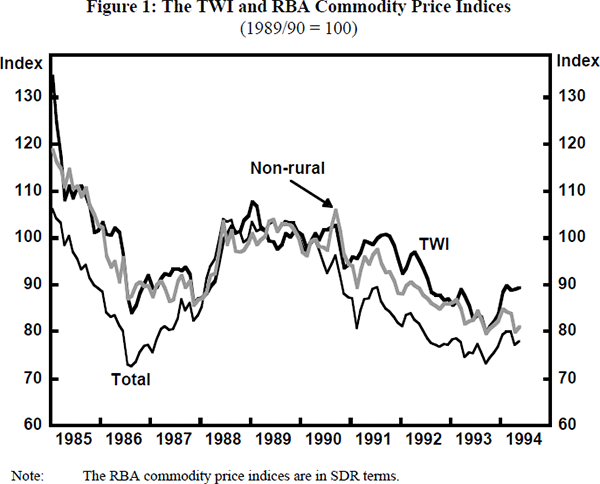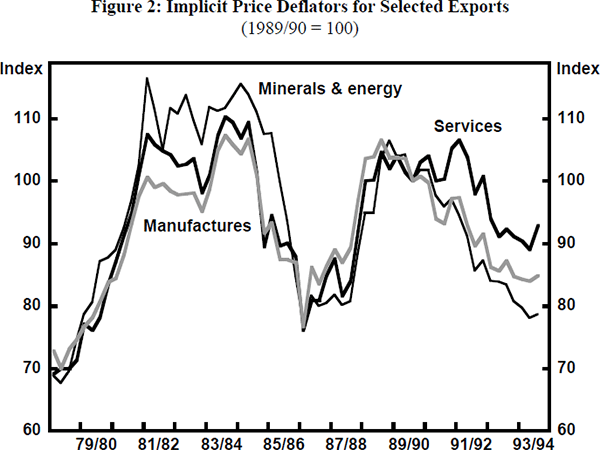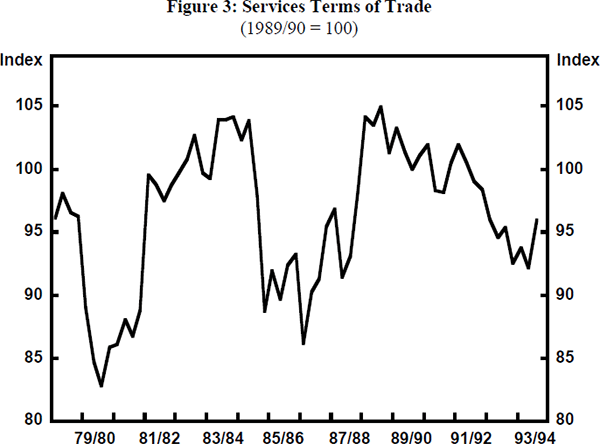RBA Annual Conference – 1994 Discussion
1. Barry Hughes
It is a considerable pleasure to be given the opportunity to comment on what will become a frequently-cited Australian paper. Gruen and Shuetrim have examined methodically the empirical links between global trading conditions, the changing structure of the goods and services balance and the Australian inflation and output condition, relying at times heavily on an impressive RBA research team effort on these and related subjects over recent years. At various points they describe their results as ‘surprising’. I hope they will not think that I am denigrating the importance of their work by suggesting that the principal results are not especially surprising. Many in the markets have similar notions in their heads. For example, I led my CS First Boston ‘fortnightly’ a month ago with a chart showing the very strong correlation between annual GDP growth in the US and Australia over the past 30-odd years (Australian Economic Digest, June 6, 1994), and nobody involved in the headaches of 1986 could have maintained faith in the notion that commodity price declines were still disinflationary. Rather, the value of, and the surprise in, the present paper is that the results come through so clearly in their empirics. I leave to others more competent the task of an econometric critique, and to those of a more pedantic bent the bowling down of the numerous quibbles that arise inevitably from such an ambitious effort in an area devoid of complete data. What struck me as being most useful for initial comment were two aspects of their work: first, their efforts to modify the disinflationary effects of terms of trade improvements for changes in the structure of goods and services exports; and second, their discussion of GDP connections.
The Volatility of the Terms of Trade
It is by now commonplace in the econometrics, as well as in market folklore, that the Australian dollar ($A) is dominated by commodity price movements. Whatever the international textbooks say about the determinants of exchange rates (and whatever the remaining shelf life, be it decades or years), for the time being, commodity prices appear to hold sway over the $A far beyond any simple effects coming through the trade balance. The efforts of Adrian Blundell-Wignall et al. in last year's Volume clearly documented the power of the relationship, though their econometrics run off the terms of trade rather than commodity prices as such. In our work, conducted independently of that in the Bank, we have found it more useful to play with commodity price indices, and the non-rural component in particular, than the terms of trade. However, the two are reasonably closely related, so that my point will stand up under either interpretation. But the piece of self-advertisement might help you to follow my preoccupations.
Given the extreme power of commodity price movements in shaping the TWI, with an elasticity close to unity, it is not surprising that increases in the former generate important disinflationary effects on landed import prices and wipe out most of the average commodity exporter's gains from improved global prices. As Gruen and Shuetrim observe, compared with the cemented peg position existing up to the mid 1970s, a commodity currency reduces the demand effect of higher resources prices as import substitutions are induced. Whatever directly-imported inflation (from the effect of global commodity price increases) that used to occur is blunted by the exchange rate, and, more importantly, a sizeable disinflation is inserted into the spiral through the higher currency's effect on landed (and, to a considerably lesser extent, retail) import prices. Nowadays a useful net disinflation should be expected over the first couple of years.
So far, so good. My problems start when the authors begin in Section 3.3 to modify their expectations of the size of the net disinflation for the changing mix of our exports. They argue that both the falling share of rural exports and the rising shares of manufactures and services exports will reduce volatility of the terms of trade, ceteris paribus, because the former items are typically more volatile, and the latter two less so, than non-rural commodities. As these structural changes unwind further, a given surge in global commodity prices should be expected to have less impact on the dollar (changing weights) and less disinflationary leverage. I am not at all sure about either modification.
The first presupposes that rural prices enter equally, pound for pound, with non-rural commodities in driving the dollar, whether the explanatory variable is the terms of trade or commodity prices. A simple glance at Figure 1 shows a much better correlation between non-rural commodity prices and the TWI than with commodities overall. In my rudimentary cointegration efforts to explain the TWI since the mid 1980s, I experience a lot of trouble getting rural prices to work. I do not know why this is so, but have rationalised the result in terms of the dominant rural commodity, wool, being little understood by foreigners. It is not in the CRB index, for example. I have even heard it said, by a foreign energy company chief, that coal prices alone drive the $A! Whatever the truth of these matters, I would feel a lot more confident about the authors' procedures if they had not placed rather more weight on the Blundell-Wignall et al. selection of the terms of trade variable as the exchange-rate driver than it might be capable of bearing in this application. It suggests also that the RBA research effort might be extended fruitfully to determine which parts of the terms of trade seem to matter for the dollar under current circumstances. It is possible that not quite enough of the textbook has yet been jettisoned.

My second problem with this section is the assumption that manufactures and services do not contribute much to terms of trade volatility and ‘we [Gruen and Shuetrim] therefore ignore them’. To date, this has not been a safe assumption to make. In SDR prices received, there has been almost as much volatility in ETM and services exports as in non-rural commodities, as illustrated in Figure 2 by the implicit price deflators from the quarterly balance of payments. One possible explanation is the J-curve assumption that ETM and services prices are quoted in Australian terms ex works or ex hotel according to domestic cost movements, so that their global price movements embody exchange rate fluctuations driven by other factors (quite possibly non-rural commodity prices). In any event, the ‘law of one price’ is a dangerous assumption to make in these areas. The final figure, again drawn from deflators in the quarterly balance of payments, shows terms of trade variations for the services trades. There has been very substantial volatility.


My point in both cases is that Gruen and Shuetrim are making strong assumptions, possibly innocently, on which to base their modifications. In the fullness of time, when the commodities' contribution to export earnings (already below 60 per cent in nominal terms) declines well below half, it would be astonishing if the results of global auction markets continued to drive the world prices of our manufactured and services exports. But for the next several years, perhaps for the rest of this century, I am not so sure that the past will suddenly cease being a useful guide to the future. In any event, there is more research work to be done before we can accept the Gruen and Shuetrim modifications, at least as baldly as stated here.
The Foreign GDP Connection
The most challenging result in the paper is the strength of the correlations between the Australian and either the US or the OECD business cycle. While the paper's equations are ad hoc, the correlations are sufficiently ‘big picture’ stuff that we need not dwell on econometric questions. Indeed, despite all the difficulties statisticians encounter in allocating GDP between quarters, the econometric links are so strong that they come through very clearly even when the dependent variable, as here, is quarterly GDP growth! These are stronger results than a casual reading of the paper might convey. That there should be links between the business cycles of trading partners is, of course, unexceptionable. But what the authors' first-cut econometrics firm-up from previous graphical and anecdotal evidence is an impression of the sheer speed and size of the links. To confirm these latter points by further probing, and hence to explore transmission mechanisms, is a challenge of the first order for both macroeconomic theory and policy.
The authors dispel any notion that simple links through the terms of trade will do the trick. If these links exist, they are of small order, and not part of the ‘big picture’, contrary to what has been commonly asserted even in recent policy discussions. They are less persuasive when it comes to positive explanation of the cyclical connections. The truth of the matter is that we have a major puzzle on our hands without a ready answer.
Apart from the graphical evidence of business cycle synchronisation hitting one between the eyeballs, we are all aware of contagious behaviour sweeping across countries. For example, late last and early this year a number of leading economies (US, Germany and Australia to name three) appeared to be displaying stronger consumption than their disposable income trends might have indicated. We do not know why this was so. The obvious first step in examining further the business cycle synchronisation, as Richard Whitelaw has suggested, is to disaggregate the comparisons into the component parts of GDP to see which, if any, are the mainstays of the aggregate link. To assume, as the authors do perhaps in astonishment, that the links are entirely asset market links is to ‘put the cart before the horse’.
In any event, there are some problems with the financial markets story. For a start, for there to be a strong similarity of contemporaneous quarterly GDP patterns, there would need to be both roughly equivalent sizes of financial shocks across countries and similar patterns of lagged repercussions, or at least deviations in either that cancelled out that in the other. At least as to size of the impact, that is not what has been happening in bond markets this year. Moreover, the shape of yield curves has been changing, steepening in Europe and Australia, but until very recently moving upwards in roughly parallel fashion in the US. Shades of the old monetarist argument come back. Do we take short rates to be important? In which case, so far there is a clear divergence between Australia, Japan and Europe on the one hand, and the US on the other. Or, do we take long rates? In this case the Australian deterioration is far greater than the others. Or, do we take the rates that seem to matter in individual countries for financing patterns (e.g. short rates in Australia and long rates in the US)?
If a direct cost-of-credit story were to be the explanation, synchronisation should be strongest in housing and other interest-sensitive expenditures. But, as the authors acknowledge fleetingly at various stages before casting aside the thought, there are other candidates. We have lived in the ‘global village’ since the 1960s, though nowadays we might call it the ‘Reuters’ or the ‘CNN village’. Information, including general economic information, is liberally sprayed around the world. A lot of it is confusing, although what happens in the US, and particularly in their stock markets, probably still helps to distil general impressions or spirits from this cacophonous ether. One alternative possibility is that this information helps simultaneously to determine the exercise or otherwise of call options on whether to go ahead or delay expansion decisions. In any given quarter some decisions have moved already to the committed stage, but, as Dixit and Pindyck remind us, many can be postponed. If this possibility has merit, the international contagion should be seen in a wider category of expenditures than the primarily interest-sensitive (e.g. employment-overtime decisions, consumption and production for stocks).
The authors have done a great service by forcing us to recognise that we have a major puzzle on our hands that is capable of altering the way we think about policy. But we are still scratching around for explanations and transmission mechanisms. Another extension of the RBA research agenda is called for.
Terms of Trade
A final short comment is called for on the authors' terms of trade model in Section 4. Although probably not their intention, both equation (1) and their written comments imply that there is only a demand side to commodity prices in the short-to-medium run. Supply-side influences are mentioned nowhere. With these latter incorporated, it is not difficult to understand why commodity prices were sicker in 1986 than 1982, despite stronger industrial production in the former year. A quantum of supply had been induced onto the market in the interim in the initially-unfulfilled expectation of good returns. And surely the Soviet metal floods of the early 1990s were very important to particular markets (e.g. aluminium, nickel). The supply side matters, even to the commodity cycle.
2. General Discussion
The discussion covered a wide range of issues. Amongst these, the most important were:
- the relationship between the terms of trade, the real exchange rate and the rate of inflation;
- the importance of international financial markets to the Australian economy; and
- the links between the Australian business cycle and foreign business cycles.
There was general agreement that identifying the relationship between terms of trade and the real exchange rate was crucial to understanding the link between the world economy and the Australian economy. There was also agreement that a strong exchange rate response to an increase in commodity prices was necessary to turn what is an inflationary shock for the rest of the world, into lower inflation for Australia, but some questioned the foundations and the robustness of this result. It was also asked whether terms of trade changes had effects on just the price level, or also on the rate of inflation. In response, it was suggested that for practical purposes the distinction is of little relevance, as price level shocks often turn into inflation shocks.
A number of participants noted that given the persistent, but temporary movements in the terms of trade, exchange rate movements often appeared excessive. It was also felt that the foreign exchange market sometimes places too much emphasis on ‘news’ which does not directly relate to Australia's ‘fundamentals’; for example, daily movements in the Commodity Research Bureau (CRB) index. (This index includes a number of commodities that are of little relevance to Australia.) Further, it was suggested that many traders in the market had relatively short horizons, and found it difficult to hold positions for long periods of time. On the other hand, the central bank with its long horizon was ideally placed to take advantage of swings in the exchange rate, and by doing so, earn considerable profits. Others wondered whether such a strong relationship between the terms of trade and the real exchange rate could be justified on theoretical grounds, and whether the relationship observed over the past decade would continue in future.
Although most participants recognised that movements in foreign asset prices are often transmitted rapidly to Australia, there was disagreement as to the impact that this has on domestic activity. A number of participants noted that unless a strong internal link could be established between Australian financial markets and domestic activity, there was no reason to believe that a strong link exists with external financial conditions. Others argued that in the late 1980s, increases in property prices as the result of widespread financial liberalisation created additional collateral which was used to underwrite bank lending. The wash-out from these developments in asset markets has been a protracted recession in a number of countries. This suggests that the high correlations between Australian and world GDP over recent years may be driven, in part, by the deregulation of financial markets undertaken in the 1980s.
In attempting to understand the correlation between the Australian and world business cycles, one participant was suspicious of the very strong short-run effects while another suggested that it would be useful to consider the international transmission of policy ideas. It was argued that in the past decade, policy ideas were exchanged between governments more actively than in previous decades. It was suggested that a good example of this was the common approach of monetary authorities to the stock market crash in 1987. On the other hand, it was argued that this story was far from complete, as the strong correlation between the Australian and world business cycles remains in the econometric exercise, despite controlling for the effects of monetary policy.
Finally, on more technical issues, several participants expressed concern over the treatment of the real exchange rate and cash rates as exogenous variables. It was argued that both of these variables may be endogenous, and as a result, the interpretation placed on the coefficients may be subject to qualification. It was also suggested that using multilateral trade weights or production weights, as opposed to bilateral trade weights, may be more appropriate in constructing an index of foreign demand and a real exchange rate index.